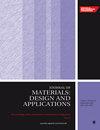提高带 ABS 核心的双管结构在轴向载荷下的耐撞性:实验和数值研究
IF 2.2
4区 材料科学
Q3 MATERIALS SCIENCE, MULTIDISCIPLINARY
Proceedings of the Institution of Mechanical Engineers, Part L: Journal of Materials: Design and Applications
Pub Date : 2024-07-23
DOI:10.1177/14644207241266081
引用次数: 0
摘要
本研究对具有矩形嵌套管(RNT)和方形嵌套管(SNT)几何形状的低碳钢双管结构进行了准静态轴向压缩试验,以评估其抗压和耐撞性能。采用多标准决策方法确定了最佳吸能结构。在所考虑的各种情况中,内管和外管之间间隙最小的 SNT 结构具有最理想的能量吸收特性。采用菱形或方形单元配置的丙烯腈-丁二烯-苯乙烯(ABS)内核可增强 SNT 结构的能量吸收性能。我们创建了一个有限元模型来评估填充了 ABS 内核的 SNT 结构的响应。通过与实验结果进行比较,确认了 ABS 内核有限元模拟的有效性以及轴向压缩下的最佳结构。在嵌套结构中集成芯材提高了防撞性能,并有助于控制结构变形。与填充方形芯材的结构相比,填充菱形 ABS 芯材的 SNT 结构具有更优越的耐撞性。填充菱形 ABS 内核的嵌套 SNT 结构的能量吸收率比相应的非填充结构高 116.93%。填充 ABS 结构的耐撞性指数对芯材的单元数和壁厚非常敏感。具有 ABS 内核的嵌套结构可作为吸能装置的新型结构。本文章由计算机程序翻译,如有差异,请以英文原文为准。
Improving the crashworthiness of bi-tubular architectures with ABS cores under axial loading: Experimental and numerical investigation
In this study, quasi-static axial compression tests were conducted on mild steel bi-tubular architectures with rectangular nested tube (RNT) and square nested tube (SNT) geometries to evaluate their crushing and crashworthiness performance. A multi-criteria decision-making approach was employed to identify the optimal energy-absorbing architecture. The SNT structure, with the smallest gap size between the inner and outer tubes, exhibited the most desirable energy absorption characteristics among the considered cases. Acrylonitrile butadiene styrene (ABS) cores, with either rhombic or square cell configurations, were used to enhance the energy absorption performance of the SNT structure. A finite element model was created to evaluate the responses of the SNT structure filled with ABS cores. The validity of finite element simulations of the ABS cores and optimal architecture under axial compression were confirmed by comparing them with experimental results. The integration of the cores into the nested architecture enhanced crashworthiness performance and contributed to the control of the structure deformation. The SNT structure filled with rhombic ABS core exhibited superior crashworthiness performance compared to the counterpart filled with square core. The energy absorption of nested SNT structures filled with rhombic ABS core can be 116.93% greater than the corresponding non-filled structure. The crashworthiness indices of ABS-filled structures were highly sensitive to the number of cells and wall thickness of the core. A nested architecture with an ABS core could serve as a novel architecture for energy-absorbing devices.
求助全文
通过发布文献求助,成功后即可免费获取论文全文。
去求助
来源期刊

CiteScore
4.70
自引率
8.30%
发文量
166
审稿时长
3 months
期刊介绍:
The Journal of Materials: Design and Applications covers the usage and design of materials for application in an engineering context. The materials covered include metals, ceramics, and composites, as well as engineering polymers.
"The Journal of Materials Design and Applications is dedicated to publishing papers of the highest quality, in a timely fashion, covering a variety of important areas in materials technology. The Journal''s publishers have a wealth of publishing expertise and ensure that authors are given exemplary service. Every attention is given to publishing the papers as quickly as possible. The Journal has an excellent international reputation, with a corresponding international Editorial Board from a large number of different materials areas and disciplines advising the Editor." Professor Bill Banks - University of Strathclyde, UK
This journal is a member of the Committee on Publication Ethics (COPE).
 求助内容:
求助内容: 应助结果提醒方式:
应助结果提醒方式:


